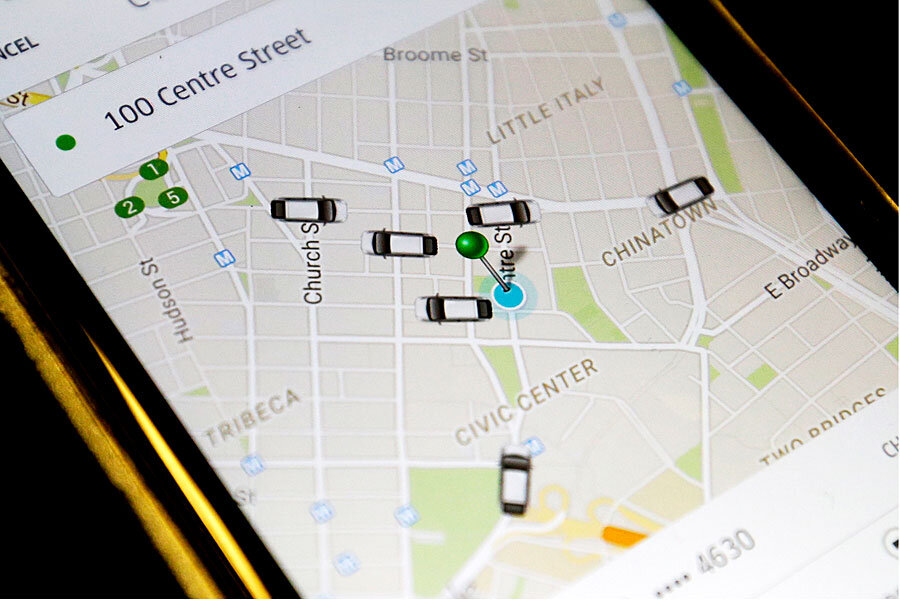AMBER Alerts for Uber: Can technology help fight crime?
Loading...
Uber’s decision to use its nationwide network of drivers to help law enforcement track down missing children is the latest mark of technology’s growing role in fighting crime and improving public safety.
The ride-hailing service on Tuesday announced a partnership with the not-for-profit National Center for Missing and Exploited Children (NCMEC) to have its drivers directly receive information about missing kids on their cell phones. The move, which advocates laud as a way to employ social media in recovering abducted children, is part of a broader effort by nonprofit and law enforcement agencies across the nation to integrate technology with public safety and police work.
“There was a time in the '80s when, if a kid goes missing, it’s front-page news, no matter where it is,” says Gavin Portnoy, executive director of digital media at NCMEC. The way news coverage has evolved, however, that’s no longer the case today, he adds. So “we leverage social media to force media markets to pay attention.”
NCMEC is one of a slew of partners, including law-enforcement agencies, broadcasters, transportation agencies, and wireless industry operators, that participates in the AMBER Alert program – a system, coordinated by the Department of Justice, that circulates information about child-abduction cases. (Amber stands for "America's Missing: Broadcast Emergency Response.") Since its inception in 1996, the program has led to the rescue of 772 children, including 20 who were recovered as a result of the wireless emergency alert program, which sends AMBER Alerts directly to users’ cell phones in the search area.
Over the past few years, NCMEC has collaborated with Google, Microsoft, Twitter, and most recently YouTube to help broaden the program’s reach. The organization’s partnership with Facebook – which brings location-based AMBER Alerts straight to a user’s feed – has been one of its most robust, says Mr. Portnoy.
“Every single person that likes our page … immediately becomes an extra pair of eyes and ears,” he says. “When something happens in your area, if you’re plugged in, you immediately become an advocate for the cause.”
Data around social media’s effect on the number of children rescued has yet to be collected, Portnoy says. But there have been success stories, including that of Ronnie Tran, a 2-year-old boy who was abducted from his Des Moines, Wash., home by his grandmother in April. The woman left Ronnie at the home of a family friend a few towns over, who didn’t realize he was part of a kidnapping until he saw the Amber Alert on his Facebook page the next morning.
The friend immediately called the police.
"I'm sitting there and I'm eating my breakfast and I'm checking my Facebook. All of a sudden I see this Amber Alert for this child and it looks like this child in my bed and I'm just like, 'Oh, my God. Like, what's going on?' ” the friend told the local NBC affiliate. “And I had my wife check and it turns out that this was the child in the Amber Alert.”
To some, however, the use of social networks to disseminate AMBER Alerts is just one small part of a much bigger trend around technology, law enforcement, and public engagement.
For one thing, with more than 460,000 children reported missing in 2014 alone, less than 800 recovered over almost 20 years is “a drop in the ocean,” says James Byrne, a professor in the School of Criminology and Justice Studies at the University of Massachusetts in Lowell.
Meanwhile, “there is a movement to use technology” to engage the public, prevent crime, and change offender behavior, he says. “It’s kind of the positive future of technology.”
Indeed, social networking is already increasingly embedded in police work, with 95 percent of police departments in the country saying they use social media in some way and more than 78 percent saying social media has helped solve crimes in their jurisdiction, according to the International Association of the Chiefs of Police Center for Social Media.
In the past few years, initiatives such as the Boston Police Department’s campaign to keep the public informed of its investigation into the 2013 Boston Marathon bombings have revealed technology’s vast potential in aiding law enforcement and improving public safety. Another example includes the use by local, state, and federal law agencies of comprehensive data search and analysis tools such as the LEAP Network, a search engine for law enforcement.
Professor Byrne also points to research on technologies designed to motivate offenders to change their behavior or predict crimes before they occur.
“That doesn’t mean we shouldn’t do it,” he says of the Amber Alert initiative, “but we should also consider putting our resources in… other areas, where the implications are much, much larger.”








